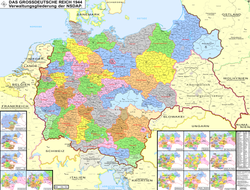Gau Swabia
|
Gau Schwaben Gau Swabia |
||||||
| Gau of Nazi Germany | ||||||
|
||||||
|
||||||
|
Map of Nazi Germany showing its administrative subdivisions (Gaue and Reichsgaue). |
||||||
| Capital | Augsburg | |||||
| Gauleiter | ||||||
| • | 1933–1945 | Karl Wahl | ||||
| History | ||||||
| • | Establishment | 30 January 1933 | ||||
| • | Disestablishment | 8 May 1945 | ||||
| Population | ||||||
| • | 17 May 1939 | 934,311 | ||||
Gau Swabia (German: Gau Schwaben) was an administrative division of Nazi Germany in Swabia, Bavaria, from 1933 to 1945. From 1926 to 1933, it was the regional subdivision of the Nazi Party in that area.
The Nazi Gau (plural Gaue) system was originally established in a party conference on 22 May 1926, in order to improve administration of the party structure. In the early stages, the borders and leaders of these Gaue fluctuated frequently, mainly due to internal power struggles. The Gau Swabia was, for the most part, identical with today's Regierungsbezirk Swabia.
The Gau Swabia came under the leadership of Karl Wahl (1892–1981), later an SS-Obergruppenführer, on 1 October 1928, when the Gau system in Bavaria was formalised, and remained under his control for the duration of the existence of the Nazi party, and later, Nazi Germany. Until 1930, Bavaria, as the heartland of the Nazi movement in the 1920s, was seen by Hitler as his personal realm, the local Gaue commonly being called Untergaue (English: Sub-Gaue), to show their dependence on the head of the party. Only when Hitler's ambitions turned national did his interest in Bavarian affairs dwindle. With the end of the internal power struggle, the following six Gaue had been established in Bavaria:
With the ascent of the Nazis to power on 30 January 1933, the so-called Machtergreifung, the party immediately began to disassemble the power of the German states, the Länder. It was envisioned by the Nazis that the Party-Gaue would take the place of the old structure. In reality, Hitler was afraid of such a move, fearing it would upset local party leaders and could possibly result in an inner-party power struggle.
In Augsburg, the Swabian capital, the Nazis did not gain a strong foothold straight away, only having received 33% of the votes at the 1933 elections. Wahl even interceded with Hitler not to dismiss the mayor of Augsburg, unsuccessfully. Nevertheless, their rise to power there could not be stopped either and by 1941, the party had 39,000 members in the city.
...
Wikipedia



